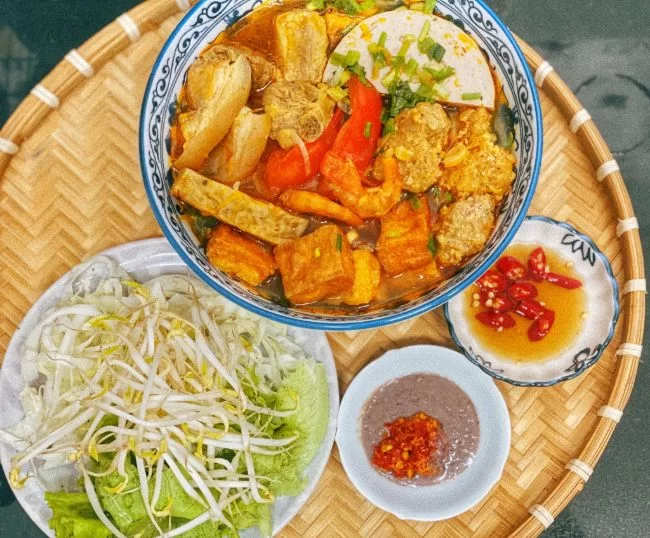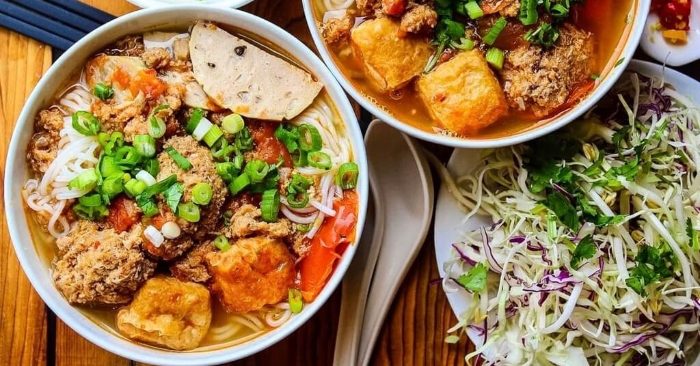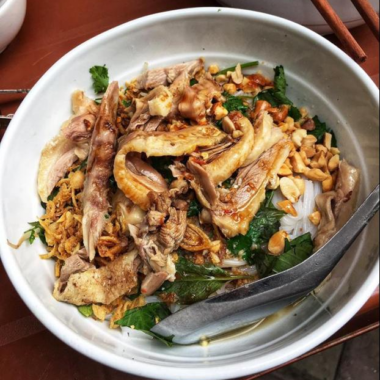Crab noodles is a rustic dish that can be found in all regions of Vietnam from small restaurants to large ones. However, these Bún riêu cua are not the same everywhere. Let’s learn about the characteristics of crab noodles with Tasty Touch in the following article!
What is crab noodles?
Crab noodles (bun rieu cua) is a traditional Vietnamese dish, widely known domestically and internationally. This dish consists of vermicelli and ‘crab soup’. “Rieu” is a sour soup cooked from crab bricks, pounded and filtered crab meat along with vertical fruits, tomatoes, fat, vinegar, fish sauce, salt, and spring onions. Bún riêu cua often add a little shrimp paste to increase the richness, often served with raw vegetables. This is a dish with a sour taste, eaten in the summer is very cool, so it is very popular with Vietnamese people.

Crab noodles, like most other noodle dishes, originate from the Northern region. Originally, crab noodles were just a row of broths cooked with crab sauce and served with vegetables and shrimp paste. Then, adding a little vinegar suddenly creates a slightly ethereal and gentle sour taste. True Northern cuisine.
Bún riêu cua then had a variation and the South advanced extremely strongly into Saigon and the southern provinces. This land is famous for its abundance, there is no shortage of fish and shrimp all year round, so the bowl of crab noodles is gradually changed and has the appearance of tofu, tomato, and pig’s blood to create a unique blend of flavors suitable for Southern cuisine. Bún riêu cua from a rustic dish have developed into a dish that requires cooking techniques, requires skilled cooks, and patiently simmering bones to create a sweet Southern taste for the broth.
Although the ingredients have the same mutual influence, in terms of taste, crab noodles in both regions of Vietnam still have strong enough differences for diners to distinguish. Northern crab noodles get their sour taste from vinegar, so it has an elegant look. Nam Bún riêu cua get their sour taste from tamarind juice, so they’re both slightly sour and sweet inside. Crab noodles in the South seem to be a little saltier than Bún riêu cua in the North, but in general, the taste is also very beautiful and stimulates the taste.
Both regions use shrimp paste as the core condiment to eat crab noodles, although the North and South shrimp paste is slightly different, in general, there are still some basic similarities. The salty shrimp paste and then squeeze the succulent lemon into the bowl to create a sour taste, season with a little chili to make it spicier with the sweetness of the broth and the crab sauce is all the sweet and sour taste.
3 Simple Steps To Make Crab Noodles
(Bún Riêu Cua) Like A Vietnamese
Course: Crab, Recipes, Rice vermicelli (Bún), Vietnamese noodles4
servings30
minutes1
hour20
minutes300
kcalCrab noodles – Bún riêu cua is a delicious dish that is popular in many different regions. Especially according to each place, the processing method also has two special features.
However, the standard bsun riêu cua is still a side dish with mixed vegetables including small salads and a view. If you like to eat vegetables, you can add a little to make the dish more diverse.
If you want to know how to cook Bún chả, you can try to visit our blog.
Ingredients
500 gr crabs
100 gr minced meat
50 grams of dried shrimp
3 pieces of tofu
4 tomatoes
2 tamarinds
2 chicken eggs
1 kg of vermicelli
50 ml of shrimp paste
Purple onion, green onion, cilantro (also known as coriander)
Raw vegetables: Can be served with water spinach, lettuce or shredded banana (if you like).
Pepper, seasoning, fish sauce, sugar, cooking oil
Directions
- Step 1: Make crab sauce
For delicious field crabs, it is best to choose dark-colored crabs.
If you want crabs to have a lot of meat, you should choose male crabs with small bibs. If you eat a lot of bricks, choose a female crab with a bigger bib.
In addition, when choosing crabs, you should choose those that are agile and moveable.
After buying, soak the crabs for about 1-2 hours to remove all the mud and sand. Then rinse several times with clean water.
Next, you peel off the crab shells and set them aside, pick up the crabs with chopsticks and gently put them in a bowl with a little ground pepper and seasoning.
In the last part of the crab shell, you put it in the mortar and pound it. Then stir with water. Squeeze it gently by the hand and filter it through a sieve to reduce dryness. After filtering, add more filtered water to promote its full effect. Do about 2-3 times, then remove the residue, keep the water.
At this point, if you don’t have time to stab, you can go out and ask someone to sharpen it. However, the crushed crabs when making vermicelli will not be as delicious as the rammed crabs.
After filtering, the crab juice is put into the pot along with the crab bricks earlier and a little salt, monosodium glutamate, and sugar. Remember to season to taste. Then put it on the stove over medium heat. Do not cook too high, it will cause the crab bricks to burn and spill out.
While cooking, use chopsticks to stir gently so that the crab sauce sticks together. When the crabs are sticky, take them out into a separate bowl.
Tomatoes cut into 4, sauteed with cooking oil. Green onions are washed thoroughly, cut into bite-sized pieces. Tofu cut into small pieces, fried until golden brown.
Add the tomatoes to boil with the crab sauce earlier, season with a little shrimp paste, fish sauce, and salt to taste. Continue cooking over low heat.
Maybe you also care about the recipe of Bún đậu mắm tôm, you can try to cook the dish with our recipe.
- Step 2: Make shrimp paste with meat
Dried shrimp soaked with a little water to soften quickly, then take out and puree.
Mixer dried shrimp with ground meat, eggs, minced fish, pureed head and sugar, and seasoning powder.
Boil the broth until it boils, then before it’s cooked, the shrimp has just been cooked.
Continue to cook until the rolls are all cooked on the surface, then turn off the heat.
If you want to get more about the list of rice vermicelli in Vietnamese food, you can try to visit our blog.
- Step 3: Complete
Sauté dried onions with cooking oil, then add crab sauce in the bowl just now, stir well and turn off the heat. This is the stage of making color water to make our crab dish more delicious and attractive.
Finally, put the vermicelli into a bowl, and evenly pour the broth and colored water on top. Add tofu, and raw vegetables to serve. You can add a little shrimp paste to bring up the smell of Bún riêu cua.
In addition, shrimp paste, if you don’t like to eat it whole, you can scoop it out into a small bowl of about 3 tablespoons and then add lemon, sugar, chili, and minced garlic. Just mouth tasting. When eating, add 1 teaspoon of mixed shrimp paste into a bowl of vermicelli. Now you are having a bowl of crab noodles, let’s enjoy it!
Recipe Video
How many calories are in Crab noodles?
Before answering the question of how many calories there are in crab noodles, let’s take a look at the main ingredients to make these Bún riêu cua.
- Fresh vermicelli: this is a grain-based food. Therefore, 100 grams of fresh vermicelli only contains about 100 calories, equivalent to the GI content in slow starches.
- Tofu: 100 grams of fried tofu in crab noodles will contain about 110 calories, this number is also quite low so you do not have to worry about gaining weight.
- Crab bricks: According to nutrition experts, a crab noodle soup will contain about 35 grams of bricks on average, and account for about 10-15 calories.
- Lean pork paste: In a bowl of Bún riêu cua, there will be about 60 grams of lean pork paste, equivalent to 100-120 calories.
- Vegetables: Common vegetables to eat with crab noodles are tomatoes, bean sprouts, lettuce, and coriander, all of which are low in calories.
So, how many calories are in a bowl of crab noodles? Based on the formula for analyzing the energy component of a medium-sized bowl of crab noodles, we can calculate the total energy of this dish to be 450 kcal. Thus, the energy in a bowl of bún riêu cua is 2.25 times higher than a cup of white rice (200 kcal) and 1.5 times higher than a cup of rice with other toppings (300 kcal).
Is crab noodles good for your health?
After you know how many calories there are in crab noodles, then we should only eat one bowl a day if we are on a diet. So what are the benefits of the ingredients in the dish?
- Fried tofu adds to the body many nutritional components such as vitamins A, C, and Magnesium… And also helps bones become strong.
- Crab bricks in crab noodles will provide our bodies with an abundant amount of calcium.
- Lean pork paste in bún riêu cua is rich in protein for the body, thereby supporting the body’s resistance, and helping muscles develop better.
In addition, in crab noodles, there are many vegetables that help the body supplement fiber content and natural nutrients to help balance the number of nutrients in the blood.

You will not worry about gaining weight if you only eat a bowl of crab noodles for breakfast because, with 465 calories, you have enough energy to function. If you want to eat 2 bowls of bún riêu cua a day, you should exercise more to increase the number of calories you burn each day.
If you can’t ensure the time to go to the gym regularly, or are afraid to go jogging. You can completely try exercising at home with simple exercises such as push-ups, using a treadmill, exercise bike… For example, you have a weight of 60kg, calories burned about approx. 4.7 calories per minute, then you need to run for 1 hour 40 minutes to burn 470 calories.
What does crab noodles taste like?
Same cooked from crabs, but Northern crab noodles are eaten with rare beef, while Southern Bún riêu cua are eaten with blood and pig’s hooves.
Crab noodle soup originated from the North, and turned into a popular breakfast food by Hanoians. The ingredients for a bowl of crab noodles are indispensable fresh vermicelli, crabs, tomatoes, vinegar, shrimp paste, and onions.
Delicious crabs are those that are opaque gray, have enough legs, the stronger they are, they always point up, their bodies are fat, their shells are shiny, and when they press on the crab bibs, they don’t sink, there are air bubbles. The cook washes, grinds, filters, and boils water to make the crab meat float and stick. To make the broth taste right, the cook puts the chopped onions on the island with oil or fat to make it fragrant, pours the crab bricks into the pot for a nice color, and then pours it into the boiling crab broth, adding vinegar, shrimp paste, and tomatoes.
Compared with the traditional bowl of Bún riêu cua, the Northern Bún riêu cua are now added with many other ingredients such as: rare stir-fried beef, spring rolls, cartilage ribs, fried tofu, duck eggs, and snails… The most delicious is at the street vendors along the old town. Diners sit on the couch, holding a bowl of hot crab noodles and enjoying themselves while watching the streets.
This noodle dish is easy to eat in both summer and winter. The mild sour taste of crab noodles makes summer less boring. In the middle of winter weather, diners who slurp a bowl of bún riêu cua with more chili will enjoy the warm spicy taste.
Unlike Northerners, Southerners’ crab noodles are cooked with more diverse ingredients, because the dish is a combination of flavors from many places.
In the South, diners can find many different types of Bún riêu cua from both ingredients and cooking methods. Basic includes vermicelli, crab, tomatoes, fish sauce, and tamarind juice. In addition, the cook also adds cashew oil so that the broth has an eye-catching red color. If the crab sauce in the Northern bowl of crab noodles is spongy, the rice in the Southern-style noodle bowl is mixed with egg yolk and ground meat, pressed into thick pieces, and chopped when eaten.
A bowl of crab noodles is full of side dishes such as blood, pork shank, or other types of fish cakes, beef rolls, or more advanced with shrimp, squid… Each restaurant has its own style of processing, very diverse and attractive.
Recently, CNN honored Vietnamese crab noodles as one of the best noodle dishes in Asia that visitors should experience. It can be said that the long journey of crab noodles, a controversial dish from its transformation, has gradually been recognized not only within the framework of Vietnam but also in the eyes of international friends.






